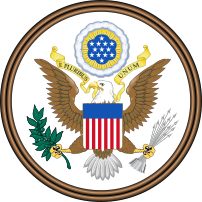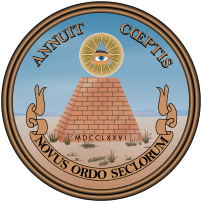The Great Seal is the seal of the United States. The phrase is used both for the impression device itself, which is kept by the United States secretary of state, and more generally for the impression it produces. The obverse of the Great Seal depicts the national coat of arms of the United States[1] while the reverse features a truncated pyramid topped by an Eye of Providence. The year of the U.S. Declaration of Independence, 1776, is noted in Roman numerals at the base of the pyramid. The seal contains three Latin phrases: E Pluribus Unum ("Out of many, one"), Annuit cœptis ("He has favored our undertakings"), and Novus ordo seclorum ("A new order of the ages").
Largely designed by Charles Thomson, secretary of the Continental Congress, and William Barton, and first used in 1782, the seal is used to authenticate certain documents issued by the federal government of the United States. Since 1935, both sides of the Great Seal have appeared on the reverse of the one-dollar bill. The coat of arms is used on official documents—including United States passports—military insignia, embassy placards, and various flags. The seal of the president of the United States is directly based on the Great Seal, and its elements are used in numerous government agency and state seals.
Today's official versions from the Department of State are largely unchanged from the 1885 designs. The current rendering of the reverse was made by Teagle & Little of Norfolk, Virginia, in 1972. It is nearly identical to previous versions, which in turn were based on Lossing's 1856 version.[2][3]
- ^ "The Arms of the United States: Criticisms and Rebuttals". The American Heraldry Society. Archived from the original on August 16, 2017. Retrieved September 30, 2017.
- ^ The Eagle and the Shield, p. xxxvii
- ^ The vector version of the obverse at the top of this article was taken from U.S. government publications, while the vector reverse was made by a Wikipedia contributor and patterned after this official one.

